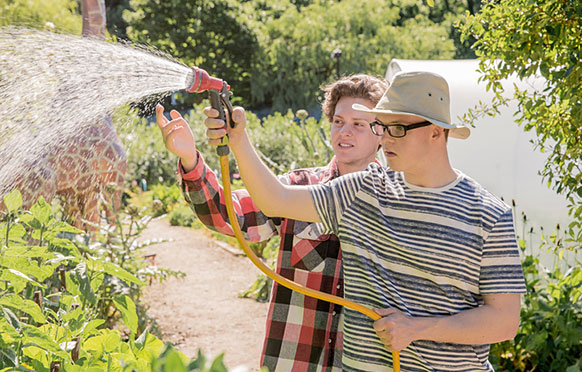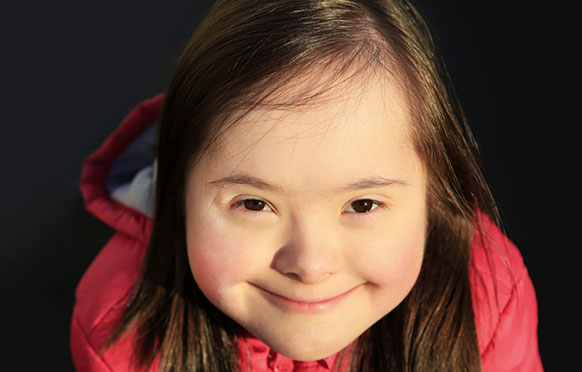
Fact Sheet FS1285
Introduction
Developmental disabilities are a group of conditions due to cognitive or physical impairments affecting learning, language, or behavior. More than 6 million individuals in the United States have developmental disabilities. Developmental disabilities occur before the age of 22, and substantially limit the individual in one or more major life activities such as understanding and expressive language; learning; self-direction; and motivation.
Learning Styles
Everyone uses multiple ways to give, receive, and store information. There are three main learning styles: visual, auditory, and kinesthetic. People generally have one preferred learning style over another. Each learning style requires different teaching and facilitation techniques. In a heterogeneous group of learners, it is important to incorporate a variety of teaching techniques to engage everyone regardless of their learning style. Below are some of the common characteristics of each learning style.
This information will help you to understand how individuals learn and what teaching techniques best fit their needs.
- Visual learning is the predominant learning style of individuals with developmental disabilities. Visual learners learn better by watching rather than listening and tend to remember details better that can be seen. When working with visual learners, be sure to utilize visual objects such as graphs, charts, pictures, objects, lists, and written instructions.
- Auditory learners learn best by listening. They depend on hearing and speaking as their main way of learning. They may use repeating skills to sort through the information that is being conveyed.
- Kinesthetic learners learn best through hands-on activities that involve physical movement and manipulation of objects. They like to touch, feel, hold, and do. Kinesthetic learners prefer to learn as they go and generally do not look at the instructions first. They often favor group activities.
Optimizing Learning in an Inclusive Environment
An inclusive environment is one that creates a sense of belonging and encourages and supports the participants. When facilitating inclusive educational programs, it is important to focus on common goals and end results for all participants, rather than the different means each learner uses to achieve them. Universal Design for Learning (UDL) is a set of principles for curriculum development that give all individuals equal opportunities to learn. UDL provides a blueprint for creating instructional goals, methods, materials, and assessments that work for everyone—not a single, one-size-fits-all solution but rather flexible approaches that can be customized and adjusted for individual needs.
When working with individuals with developmental disabilities, you might need to make accommodations to optimize learning. Accommodations might include adapted heights of seating or tables; color-coded kitchen utensils; adapted equipment or lighting; providing instructions and information using verbal communication as well as pictures; assigning a different or modified task; or completing an activity in another area of the room.
Consider these questions to help optimize learning for an individual with a developmental disability who is participating in an inclusive program:
- Can the individual participate in the same activity in the same way as other program participants? If not, can the individual participate in the same activity with adapted materials or expectations? For example, activity instructions are provided using pictures and/or minimum words.
- Can the individual participate with the group while working on a different activity for a different purpose? For example, the individual can monitor time for the group or get items from the supply table.
- Can the individual participate in a different activity in the classroom or meeting space while the others are working in another part of the room? For example, the individual can work on a computer while others do a writing activity.
Instructional Techniques to Enhance Learning
When working with people with developmental disabilities, learning can be enhanced by utilizing a variety of instructional techniques. Some recommended and universally accepted techniques include:
- Break tasks down into small, manageable steps.
- Use as many of the individual's senses as possible.
- Model or demonstrate each step of the activity.
- Build on each successful accomplishment.
- Pace the lesson or activity according to the needs and abilities of the group and allow for slower processing time when asking questions and assigning tasks.
- Vary your instructional time between passive and active activities. In addition, a movement break will help learners to recharge and refocus.
- Build in as much routine, structure, and predictability as possible.
- Use visual supports and cues such as pictures, videos, photos, or drawings, schedules, timers, and written instructions to accompany verbal directions, models, etc. If verbal directions are difficult for the learner to understand and process, use visuals widely around the learning environment. This will make following directions easier and will increase the student's independence—resulting in enhanced learning, an engaged student, and less problematic behavior. Visual supports and cues are especially useful when explaining what is going to happen next.
- Use simple one-step directions stated in a clear and concise manner. It is important to repeat directions by rephrasing them in a variety of ways to ensure understanding.
- Prompt as needed to increase understanding and participation. Prompting can take many forms. For example, you can verbally prompt by asking questions or offering part of the answer and have the individual finish the thought or sentence. Visually prompt with a checklist or picture cue or even physically prompt by demonstrating or gesturing as a guide. Once the participant gets the hang of it you want to reduce prompting, so the learner functions more independently.
- Provide rewards to encourage learning and engagement. Individuals with disabilities are very positively impacted by verbal praise or a "high five;" positive reinforcement; a specific motivator such as working toward a goal of a simple token reward; or special recognition such as a certificate or sticker. Rewards and reinforcements need to be offered frequently to acknowledge small positive actions. The material value of the reward is not important.
- Plan activities that encourage opportunities to practice a new concept over and over.
- Break up instructional time and vary your teaching techniques.
- Individuals with developmental disabilities learn best by doing hands-on activities. Utilize highly motivating activities that are hands-on and that capitalize on the learner's areas of interest.
- Ask the participant to "teach back" the direction to confirm their full understanding. This is also a model that can be used to foster leadership development skills and independent living skills.
Disability Awareness and Sensitivity
Showing respect for others' dignity is extremely important at all times. A disability is a functional limitation that interferes with a person's ability to walk, talk, learn, etc. The term handicap describes a situation or barrier imposed by society or environment. The suggestions below are valuable when working with any learners but are key when working with clientele with developmental disabilities:
- Use person-first language that describes what a person has rather than what a person is. For example, "Stanley has autism" rather than "Stanley is autistic".
- If you are uncertain about what language or terms to use when speaking to a person with a disability, ask the person. Use terms that person prefers.
- Emphasize the person's abilities, rather than his limitations.
- Choice and independence are important; let the person do or speak for himself/herself as much as possible.
- Try not to give excessive praise or attention to a person with a disability or to use words that evoke pity.
Retaining What We Learn
The proverb "Give a man a fish and you feed him for a day; teach a man to fish and you feed him for a lifetime," reminds us that it is more worthwhile to teach someone to do something rather than to do it for him.
We retain 20% of what we read; 20% of what we hear; 30% of what we see; 50% of what we see and hear; 70% of what we see, hear, and discuss; and 90% of what we see, hear, discuss, and practice. To meet the variety of learning needs of program participants, educators should utilize a variety of instructional methods in order to enhance learning and retention.
Summary
Everyone learns differently. To support an engaging learning environment for all participants, various teaching methods should be used. The key is to be aware of, accept, and work with each participant's learning style and their individual special needs. Offer the information in a variety of formats and be flexible, patient, organized, and creative. Every person has the potential to learn. It is the educator's job to discover and maximize that potential. Make the most out of each person's strengths. It is important to continue to learn about developmental disabilities and effective instructional strategies so you can make a positive difference in your participants' lives.
Additional Training
Training is available for individuals who provide programming and/or support to youth and adults with developmental disabilities. The Skillfully Working with People with Developmental Disabilities training series is available online through a partnership with Colorado State University.
References
- AbilityPath. (2020). Children’s Learning Styles. Retrieved March 29, 2024, from https://abilitypath.org/ap-resources/childrens-learning-styles/
- CAST. (2018). About Universal Design for Learning. Retrieved on March 29, 2024, from https://www.cast.org/impact/universal-design-for-learning-udl
- Centers for Disease Control and Prevention. (April 2020). Communicating With and About People with Disabilities. Retrieved on March 29, 2024, from, https://www.cdc.gov/ncbddd/disabilityandhealth/materials/factsheets/fs-communicating-with-people.html
- Centers for Disease Control and Prevention. (2018). Facts about Developmental Disabilities. Retrieved on March 29, 2024, from https://www.cdc.gov/ncbddd/developmentaldisabilities/facts.html
- Gilpatrick, M., Vasquez, T., & Pottinger, E. (January 2024). Why Is a Growth Mindset Important in the Classroom? Grand Canyon University. https://www.gcu.edu/blog/teaching-school-administration/why-growth-mindset-important-in-classroom
- Rutgers Cooperative Extension. (n.d.). Skillfully Working with People with Developmental Disabilities. Colorado State University. Retrieved April 22, 2024, from https://www.online.colostate.edu/badges/developmental-disabilities/
This publication is based on the work of Jeannette Rea Keywood, 4-H Agent and Michelle Brill, Family and Community Health Sciences Educator.
July 2024
Copyright © 2025 Rutgers, The State University of New Jersey. All rights reserved.
For more information: njaes.rutgers.edu.
Cooperating Agencies: Rutgers, The State University of New Jersey, U.S. Department of Agriculture, and Boards of County Commissioners. Rutgers Cooperative Extension, a unit of the Rutgers New Jersey Agricultural Experiment Station, is an equal opportunity program provider and employer.



